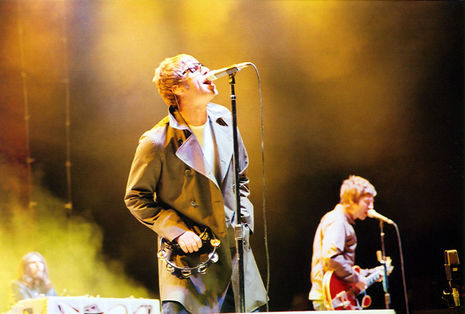‘Experimental while distinctly Gallagher’: C’mon you know review
Oliver James reviews Liam Gallagher’s new studio album and praises Gallagher’s experimental direction

We used to know what to expect when Liam Gallagher released a new album. After all, his first solo LP, As You Were (2017), marked an almost seamless continuation of his own songwriting contributions to the Oasis releases of the late 2000s. Why Me? Why Not (2019) was even more of a fan-pleaser, employing his crowing vocals to delightful measure in a relentless assembly of rocking numbers, both red meat to his following and a fortification for his live set-lists.
So, what were we predicting back in October when Gallagher announced, in typical fashion, a “biblical” third studio album, C’mon You Know, for the end of May? The first indication came with the release of its lead single, “Everything’s Electric”, in April. A classic Gallagher number that gives just the right space for his uniquely snarled and powerful vocals, the rolling riff and thunderous chorus are ripe for ear-splitting festival reproduction and the very mosh pit scenes depicted on the LP’s cover artwork.
“At no point does it feel that Gallagher has bitten off more than he can chew”
Immediately upon hearing the album’s opener, “More Power”, however, you can tell that we are in for something very different. Whereas the equivalent tracks on both preceding LPs had greeted us with screeching electric guitar and roaring vocals, this opener begins with the lilting melodies of a child choir and leads into a mellow and lyrically impassioned ballad. Here is the first indication of a new Gallagher: reflective, wistful and apologetic in equal measure, wonderfully at ease with the composition, even if his voice doesn’t initially seem suited to traversing this new terrain. Indeed, the album’s other Side One ballad, “Too Good For Giving Up”, is perhaps the stronger, if less experimental, of the two, delivering a driven and satisfying melody more reminiscent of his preceding works. Ezra Koenig’s influence as co-writer and producer of the orchestral, psychedelic and wonderfully haunting “Moscow Rules” is evident, but I actually found the more overtly Vampire Weekend-esque tune to be “It Was Not Meant To Be”, harnessing a ringing, and distinctly summery, backing tune worthy of the 2019 album Father of the Bride. The masterfully produced “World’s In Need” provides yet another twist with an unmistakeably 90s folk feel, although it lacks a killer culmination to a delightful chorus build, while “I’m Free” cleverly pairs an aggressive vocal onslaught with short reggae instrumentals that are reminiscent of early 80s ska.
Perfectly encapsulating the sheer extent of the album’s creative breadth, at no point does it feel that Gallagher has bitten off more than he can chew with these experimental offerings, adeptly navigating them with palpable self-confidence. Gallagher can’t help returning to his bread and butter in several songs, though, with the record’s brash and booming title track providing such a fix. Harbouring noticeably more depth than preceding releases, Gallagher hammers the four-syllable refrain at the end of each verse, before unleashing a searing chorus bound to galvanise the Knebworth masses. “Better Days” is another such track, greeting the listener with a wall of noise and reaching a simple and spacious choral hook, while harnessing a delightful rattling drum beat resembling Ringo Starr’s contribution to the Beatles’ 1966 avant-garde track “Tomorrow Never Knows”. The remarkably fresh and bouncy Arctic Monkeys-esque “Diamond in the Dark” is probably my favourite number of the album, harking more explicitly back to the Beatles in its “A Day in the Life”-inspired lyrical refrain: “Now I know how many holes it takes to …” As the second track, it serves as a return to ground from the divine choral tones of the opener, while also leading neatly to “Don’t Go Halfway”, a similarly paced tune which feels somewhat lost at points but harbours the necessary rhythmic momentum, especially in the hard-hitting chorus, to render it a powerful addition.
“None of these tracks could be considered a waste of eartime”
Unsurprisingly, the conclusion of Side Two holds the weaker songs, with “Oh Sweet Children” particularly staid, while the deluxe bonus track “Wave” feels like a slightly muddled closing track for the album’s digital version. That being said, none of these tracks could be considered a waste of eartime, and all provide further evidence of an artist willing to diversify his musical contribution at the expense of a more polished collection of tracks.
So, what should we make of C’mon You Know? There is no doubt that, over the course of the album, Gallagher is more comfortable in his element, belting truculent riffs over scalding guitar, as we are treated to in the few tracks that unleash this in prime form. But that’s what’s so interesting about this LP. Gallagher summarises that “80 per cent of the record’s a bit peculiar … and 20 per cent of it’s kind of classic”. Although untidy in places, the beautiful layers of lyrical emotion, psychedelia and romanticism, coupled with a touch of the orchestral and avant-garde, provide us with an LP that diverges from his Oasis era of songwriting in breadth and experimental value, while remaining distinctly Gallagher from start to finish. In that regard, C’mon You Know sits comfortably at the top of his growing collection of solo albums. Perhaps this is a sign of things to come, or maybe he will be unable to resist the lure of returning to the tried and tested two years down the line. Either way, what we do know is that Liam Gallagher is still here, as “mega” as ever, and he’s certainly not going anywhere.
 News / Downing investigates ‘mysterious’ underground burial vault 29 December 2025
News / Downing investigates ‘mysterious’ underground burial vault 29 December 2025 News / Unions protest handling of redundancies at Epidemiology Unit30 December 2025
News / Unions protest handling of redundancies at Epidemiology Unit30 December 2025 Lifestyle / Ask Auntie Alice29 December 2025
Lifestyle / Ask Auntie Alice29 December 2025 Features / ‘Treated like we’re incompetent’: ents officers on college micromanagement30 December 2025
Features / ‘Treated like we’re incompetent’: ents officers on college micromanagement30 December 2025 Science / Astronomical events to look out for over the break29 December 2025
Science / Astronomical events to look out for over the break29 December 2025










